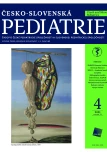Current trends in the management of inguinal hernia in children
Authors:
Zahradníková Petra 1; Fědorová Lenka 1; Vnenčák Tomáš 2; Francisty Tomáš 2; Nedomová Barbora 3; Babala Jozef 1
Authors‘ workplace:
Klinika detskej chirurgie, Lekárska fakulta Univerzity Komenského v Bratislave, Národný ústav detských chorôb, Bratislava
1; Chirurgické oddelenie s JIS, Nemocnica Poprad, a. s.
2; Detská klinika anestéziológie a intenzívnej medicíny, Lekárska fakulta Univerzity Komenského v Bratislave, Slovenská zdravotnícka univerzita, Národný ústav detských chorôb, Bratislava
3
Published in:
Čes-slov Pediat 2023; 78 (4): 215-219.
Category:
Case Report
doi:
https://doi.org/10.55095/CSPediatrie2023/038
Overview
Inguinal hernia is one of the most common surgical diagnoses in childhood and is often diagnosed during the first year of life. Clinically, the inguinal hernia usually manifests as a bulge in the groin area and represents the protrusion of the organs of the peritoneal cavity through a preformed or secondary made aperture. An inguinal hernia can also manifest as a stiff, significantly painful resistance in the groin or scrotum area, which cannot be freely reponed, it is a so-called „incarcerated“ or strangulated inguinal hernia. An incarcerated hernia in a child is one of the acute abdominal events. Treatment of inguinal hernia is only surgical. Non-incarcerated inguinal hernia surgery is a planned procedure. The aim of the article is to offer an overview of current surgical methods in the treatment of inguinal hernia in children. The operations of inguinal hernia in children can be performed in several ways. In addition to open inguinal surgery, a minimal invasive approach can also be chosen, using the PIRS (Percutaneous Internal Ring Suturing) method, or the laparoscopic purse-string method, or other laparoscopic approaches. Inguinal hernia is operated under general anaesthesia. Inguinal hernia operations in children can also be performed in the form of one-day surgery.
Keywords:
inguinal hernia – herniotomy – PIRS – purse-string – minimally invasive surgery in children
Sources
1. H orn F, et al. Detská chirurgia. Slovak Academic Press 2014: 262–266.
2. Šnajdauf J, et al. Detská chirurgie. Praha: Galén, Karolinum 2005: 268–272.
3. Zeman L, et al. Onemocnění skrota v dětském věku s přihlédnutím k problematice akutního skrotálního syndromu. Čes-slov Pediat 2001; (8): 443–447.
4. Vidiščák M, et al. Novorodenecká chirurgia. M-SERVIS 2008: 73–77.
5. A bdelghaffer A, et al. Inguinal hernia in infancy and children. Intechopen 2017: 65–69.
6. Zallen G, Glick PL, et al. Laparoscopic inversion and ligation inguinal hernia repair in girls. J Laparoendosc Adv Surg Tech 2007; 17: 143–145.
7. P atkowski D, et al. Percutaneous internal ring suturing: a simple minimally invasive technique for inguinal hernia repair in children. J Laparoendosc Adv Surg Tech A. 2006; 16(5): 513–7.
8. A kgun O, et al. Effects of laparoscopic hernia repair by PIRS (percutan internal ring suturing). Technique on testicular artery blood supply. J Invest Surg 2019; 32(4): 343–347.
9. K ilda A, et al. High recurrence rate of childrens inguinal hernia after percutaneous internal ring suturing: a single-center study. Hernia 2021; 25 3): 797–801.
10. E l-Gohary MA, et al. Laparoscopic ligation of inguinal hernia in girls. Ped Endosurg Innov Tech 1997; 1: 185–188.
11. P rasad I, et al. Early experience with needleoscopic inguinal herniorrhaphy in children. J Pediatr Surg 2003; 38: 1055–1058.
12. M ontupet P, et al. Laparoscopic treatment of congenital inguinal hernia in children. J Pediatr Surg 1999; 34: 420–423.
13. S chier F, et al. Laparoscopic herniorrhaphy in girls. J Pediatr Surg 1998; 33: 1495–1497.
14. S chier, F, et al. Laparoscopic surgery of inguinala hernias in children-initial experience. J Pediatr Surg 2000; 35: 1331–1335.
15. P atkowski D, et al. The efficacy of percutaneous internal ring suturing (PIRS) – a simple minimal invasive technique for inguinal hernia repair in children. J Lap Adv Surg Tech 2006; 16: 513–7.
16. Priyadarshini K, et al. Ultrasound-guided transverse abdominis plane block, ilioinguinal/iliohypogastric nerve block, and quadratus lumborum block for elective open inguinal hernia repair in children: a randomized controlled trial. Reg Anesth Pain Med 2022; 47(4): 217–221.
17. Wolak PK, et al. Percutaneous internal ring suturing (PIRS) – the benefits of laparoscopic inguinal hernia repair. Ther Clin Risk Manag 2022; 18: 135– 144.
18. M acías A, et al. Regional anesthesia techniques for pain management for laparoscopic surgery: a review of the current literature. Curr Pain Headache Rep 2022; 26(1): 1–10.
19. L ee DY , et al. A purse-string suture at the level of internal inguinal ring, taking only the peritoneum leaving the distal sac: is it enough for inguinal hernia in pediatric patients? Hernia 2015; 19: 607–610.
20. P armeggiani P, et al. Decreased recurrence rate in the laparoscopic herniorraphy in children: comparison between two techniques. J Laparoendosc Adv Surg Tech A 2009; 19: 259–262.
21. Gause CD, et al. Laparoscopic versus open inguinal hernia repair in children <3: a randomized controlled trial, Pediatr Surg Int 2017; 33: 367–376.
22. E sposito C, et al. Laparoscopic inguinal hernia repair in premature babies weighing 3 kg or less. Pediatr Surg Int 2012; 28(10): v989–92.
23. Balogh B, et al. Outcomes of laparoscopic incarcerated inguinal hernia repair in children. J Minim Access Surg 2020; 16(1): 1–4.
24. T akehara H, et al. Laparoscopic surgery for inguinal lesions of pediatric patients. Proceedings of the 7th World Congress of Endoscopic Surgery 2020: 537–542.
Labels
Neonatology Paediatrics General practitioner for children and adolescentsArticle was published in
Czech-Slovak Pediatrics

2023 Issue 4
Most read in this issue
- Periodic fever syndrome, autoinflammatory diseases
- Current trends in the management of inguinal hernia in children
- Spinal muscular atrophy in newborn
- The use of contrast-enhanced ultrasound in diagnosis of liver tumors in newborns
